Antigua: A Very Brief History
Antigua, Guatemala, is a city of about 30,000 people and a UNESCO World Heritage Site. The majority of Antigua is contained in a 7-by-7 grid of cobblestone streets. In the 18th century, it was the Spanish colonial capital of Central America. Its chief exports were cochinilla (cochineal) red dye, and indigo. At this time, the city was largely controlled by the Catholic Church, which was the center of civic, religious, and political life.
In 1773, a 7.9 magnitude earthquake caused substantial death and destruction, and subsequently, the bulk of the city’s population moved away. It remained depopulated for several decades. The Spanish crown took this opportunity to wrest power away from the Church, and establish its dominance more firmly. The capital was moved to nearby Guatemala City, which is still the capital of Guatemala today. It was a long time before restoration began in Antigua. Because of this, and the modern UNESCO status, at least on the surface, the city retains a lot of its 18th century appearance.
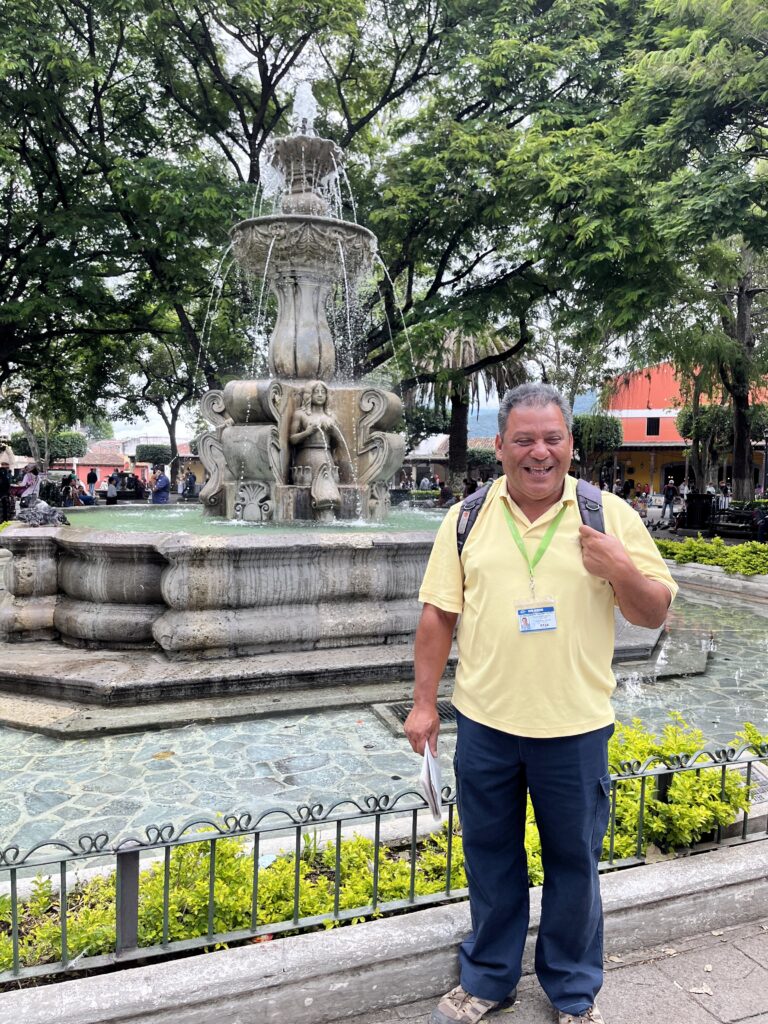
First Impressions of the City
The buildings have characteristically high cement exterior walls. Many are plastered and painted in bright solid colors. Others are visibly aged, with flaking paint and crumbling masonry. It’s common to see razor wire topping these walls. Windows have iron bars, and entry doors are made of heavy wood or metal. Overall, it’s not an overly friendly architectural style. There are so many people who are in love with the Spanish Colonial architecture, and Antigua is widely regarded as a super quaint, beautiful city. But the buildings don’t do much for me aesthetically. From the street, everything looks closed off, forbidding, and somewhat bland–even though there’s colorful paint, there’s not a lot of variety in exterior appearance. But just about every property hides a lovely secret: a courtyard full of tropical plants. So if you get up onto one of the many rooftop terraces, you can see down into all these lush private edens. And you realize that often, what looks from the outside like a business or home is actually just an empty space full of grass and broken walls.
Beyond the city limits, the dormant and lushly forested Volcán de Agua dominates the southern horizon. On a clear day, you can see the twin peaks of Volcán de Acatenango and Volcán de Fuego in the southwest. Fuego is very active. It’s the kind of volcano that I think most people imagine when they hear the word “volcano”–a formidable conical mountain, spewing smoke and lava from its peak. By contrast, Kilauea, the active volcano on my home island, is (usually) less dramatic. Fuego belches up a cloud of thick gray smoke every 30 minutes or so. And if you’re close enough, you can hear the explosive rumblings.
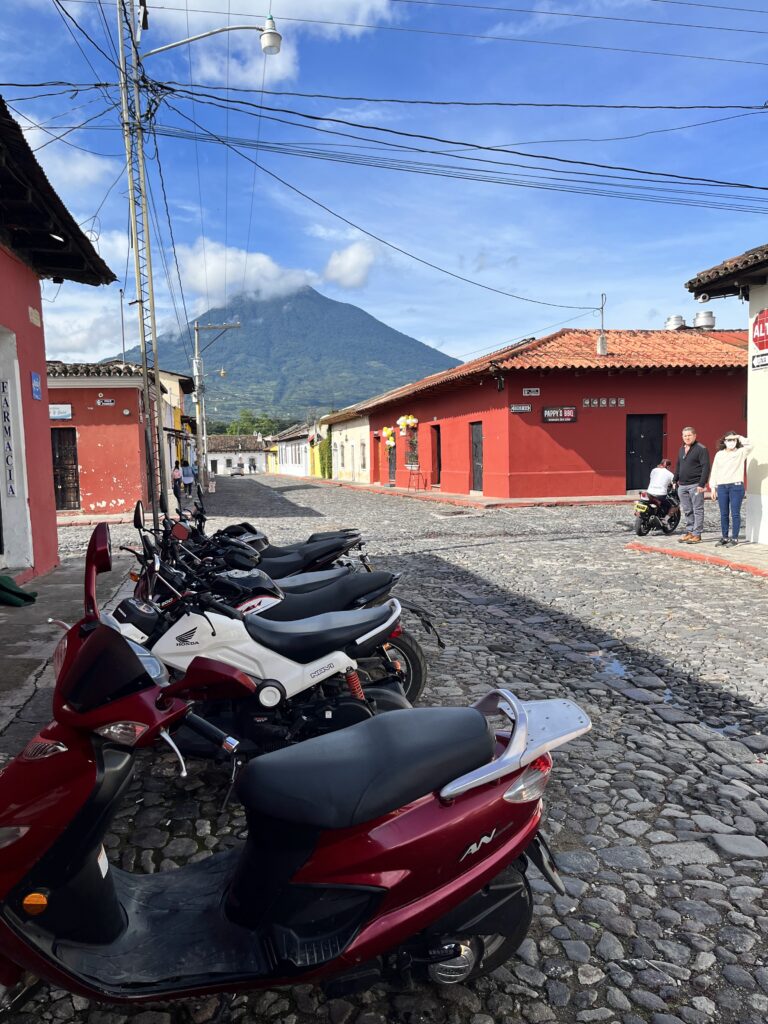
When you’re not ogling the landscape, it’s also cool to find historic ruins scattered throughout the city. You’ll just be walking along between businesses and houses, when suddenly you see something leftover from the 1700s. In some destroyed buildings, boulder-sized chunks of broken ceilings sitting where they fell, haphazardly strewn on the ground, now exposed to the elements and covered in moss.
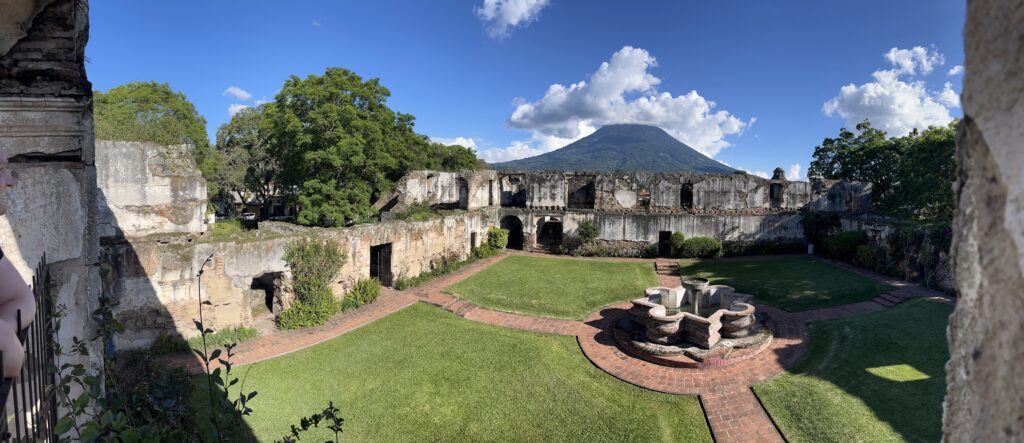
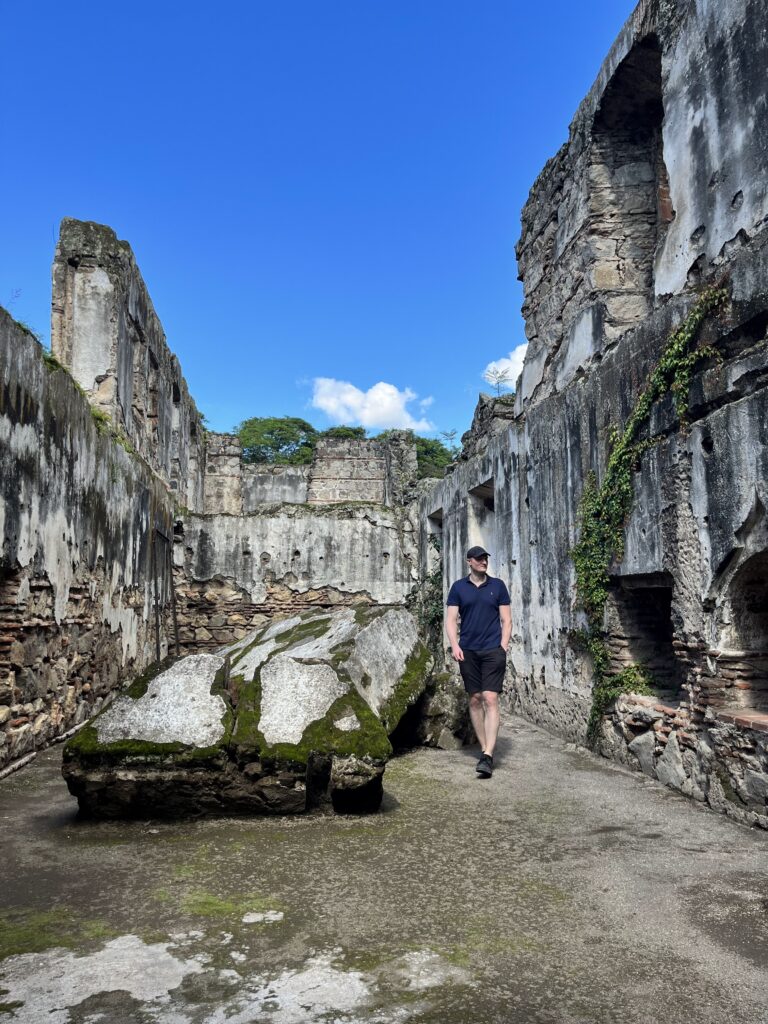
Rainy Season
I visited Antigua during Central America’s rainy season (June-November). Similar to Hawaii, there are really only two seasons here: wet and dry. Less like Hawaii, the rain follows a predictable daily pattern. It’s almost always dry during the morning, and then in the afternoon or evening there is a significant downpour. This wasn’t the case every day (actually during my final week in Antigua, it was pretty dry in the afternoons and evenings). However, it is usually a good idea to bring your rain jacket out with you. It’s also advisable to have shoes that can handle puddles and cobblestones simultaneously.
Street Life
Traffic in Antigua moves pretty slowly because of the cobblestones. There are no traffic lights, just stop signs. Lots of people ride motorcycles, which seem to handle the bumps better than the cars do. There are also a lot of motorized tuktuks, which a friend told me are manufactured by a company in India. The sidewalks are narrow, and often cracked or uneven.
There are quite a few stray dogs roaming around, all the ones I’ve seen have been either very friendly or totally disinterested in me. I’ve heard that in other parts of Latin America, they can be pretty aggressive. Between the irregular sidewalks, the cobblestones, and the dog poop, you need to watch where you step. But there is actually less dog poop on the sidewalk than in some parts of Denver. In Colorado I get pretty frustrated by this because I feel like it’s a sign of dog owners being entitled and inconsiderate. But here, there’s not really anyone to be upset at. There’s also not too much litter here, thanks to city employees who are out on cleanup duty early in the morning.
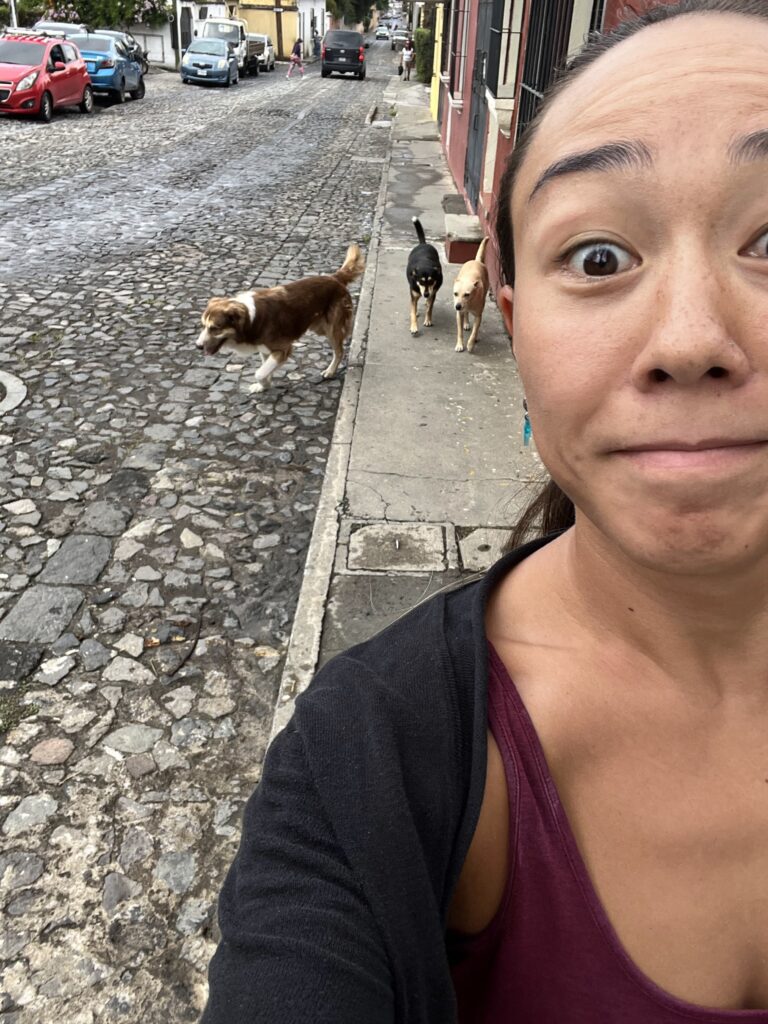
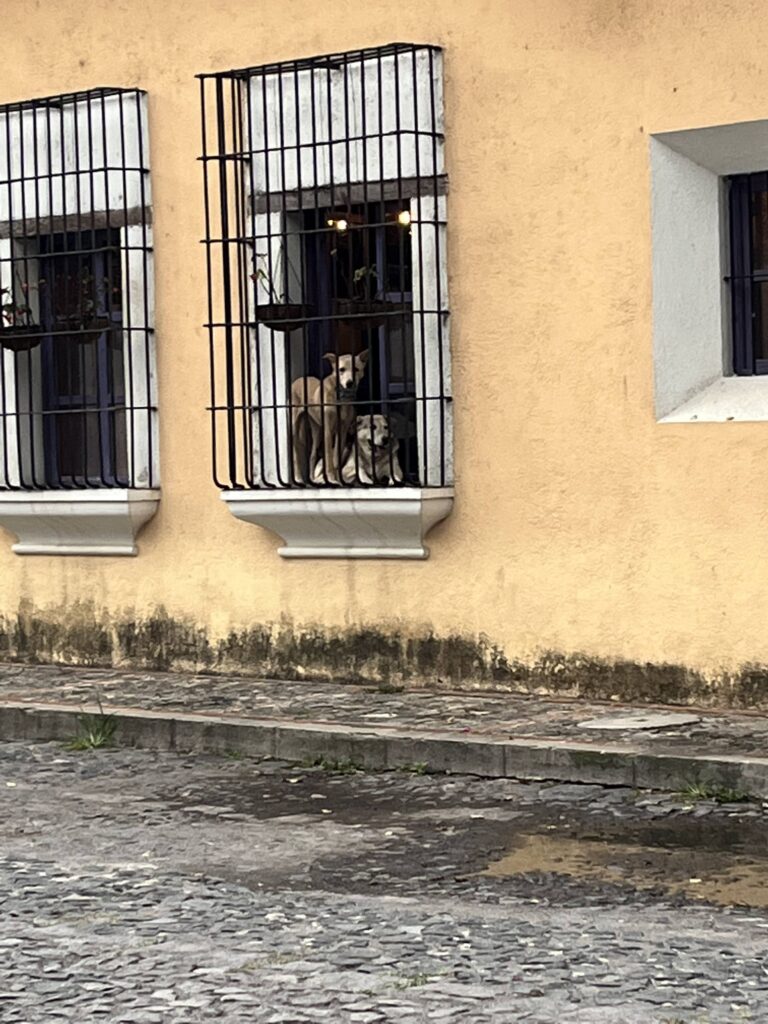
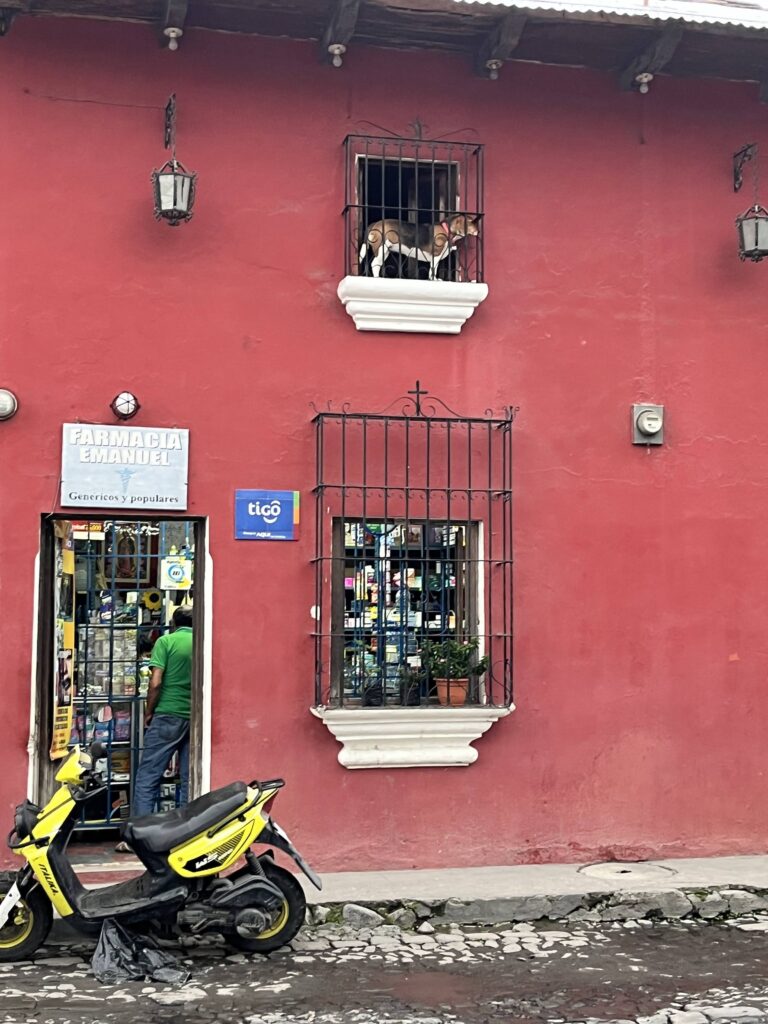
It’s common to hear and see “bombas” throughout the day. These are small, airborne firecrackers that explode in a little puff of smoke. They’re particularly frequent on Sundays, as Guatemalans are majority Catholic, and it’s a popular way to mark the day of rest. I was visiting during Corpus Christi, which is a Catholic holiday that celebrates the Eucharist. I don’t fully understand the significance or why it was going on for three consecutive weekends. But every Sunday, the cobblestone streets were strewn with flowers, alleys and churches were decorated with yellow and white streamers, and people walked in processions through town–sometimes in costume, sometimes with musicians. It was a pretty festive atmosphere.
Even when it’s not a holiday, in the streets, people greet strangers as they cross paths. Buenos días, buenas tardes, hola. Reminds me a bit of hiking in Colorado. Not every single person is going to say hi, but it’s pretty common to acknowledge one another, which is not something that you see in a lot of places in the US.
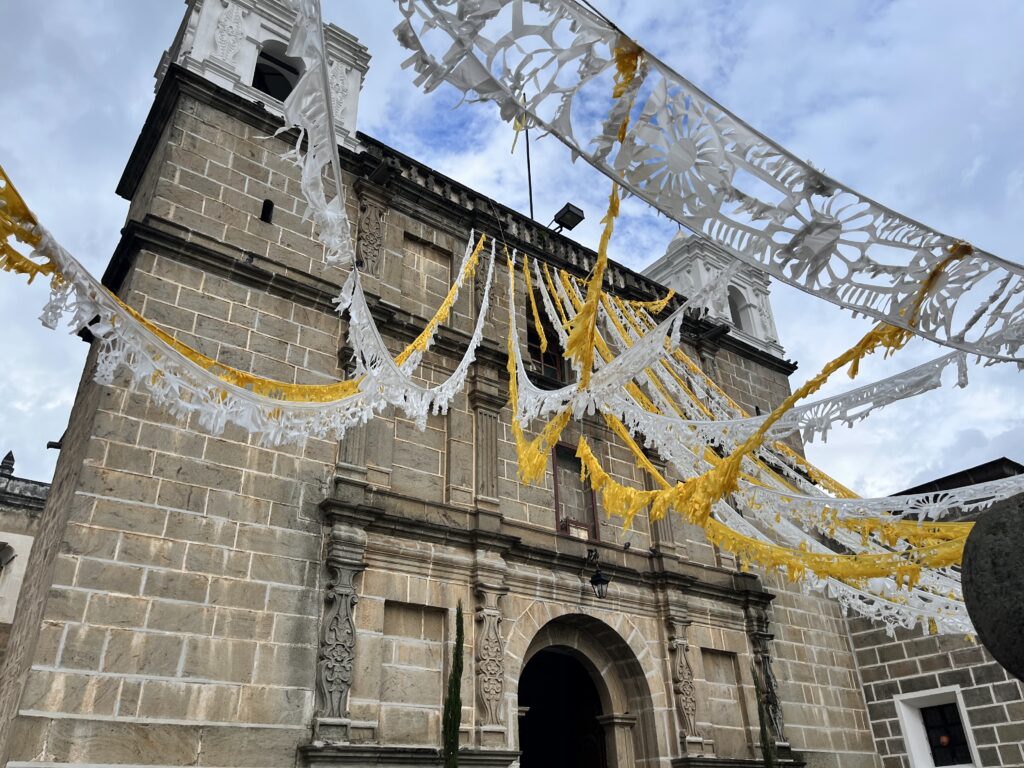
First Stop on the Gringo Trail
Antigua has a reputation for being very touristy. It’s on Guatemala’s so-called “Gringo Trail,” a short list of must-see spots where you’re likely to encounter all the foreigners. Because of its UNESCO status and proximity to the capital, it is one of the first places that most tourists come to visit when they arrive in this country. It’s also a hub for Spanish schools. I’ve heard that pre-COVID, there were over 70 operating here. You can tell that the locals are used to it. Their economy relies heavily on tourism. Lots of the local people speak some English, especially in hostels, hotels, restaurants, travel agencies, etc. But they’re also very patient about letting you attempt to use Spanish with them–even if it’s terrible.
If you’re near El Parque Central or Arco de Santa Catalina, you’re absolutely going to see a bunch of people selling tourist trinkets. Lots of traditionally dressed Mayan women sitting along sidewalks with their children and a blanket covered in colorful handicrafts. Or men walking around laden down with wooden percussion instruments, playing one with a mallet. And occasionally someone wearing a stack of Panama hats that is taller than they are, like in that old kids’ book, Caps for Sale. People will definitely try to price gouge in these contexts, but even a ripoff in Quetzales is less expensive than anything you’d pay in dollars. Personally, I’m still shy about bargaining, and also I have no room to take anything else in my bag. So I’ve solved the problem by not buying anything.
I’ve heard that pre-pandemic, it was a lot more busy here, and things are just starting to pick up again. Overall, the attitude toward tourists seems less conflicted than it does in Hawaii, where we’re beholden to tourism dollars, but also sometimes just wish they’d go away. Or maybe I just haven’t gotten to know any Guatemaltecos well enough for them to be honest with me about their animosity. But everyone I’ve interacted with has been very nice to me.
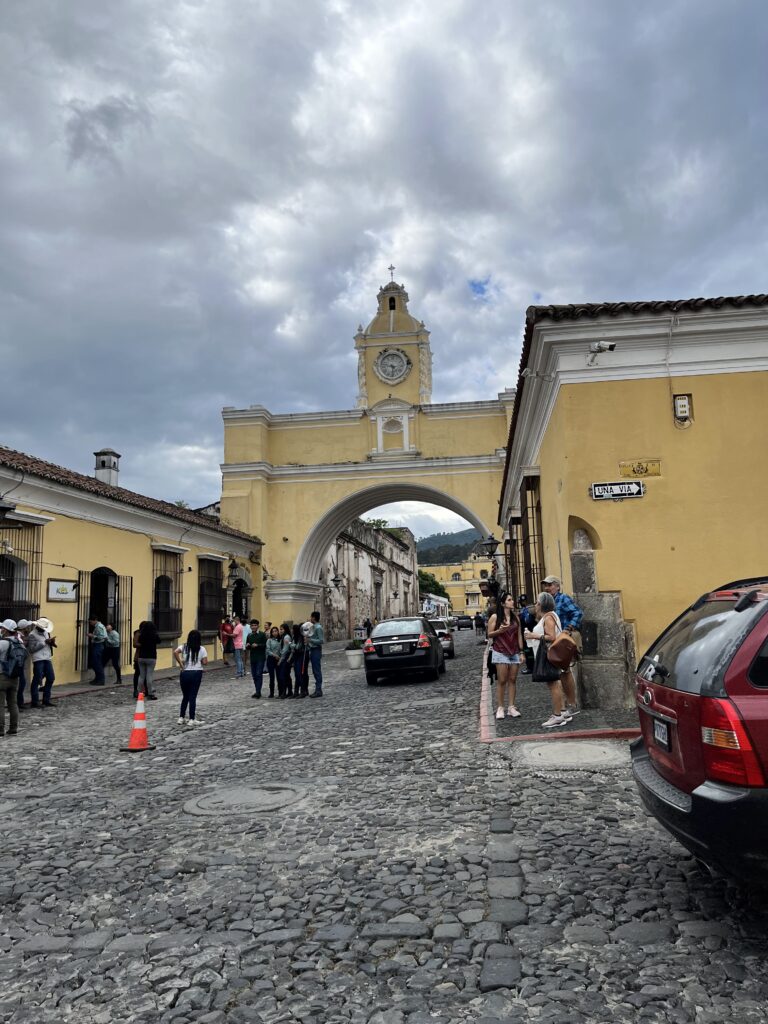
A Soft Landing
I wrote previously about how I was initially hesitant to come to a touristy place. I do think I would have learned a lot more Spanish in the last few weeks if nobody around me spoke English. But I have actually really enjoyed being in a place that’s frequented by adventurous young people from all over the world. A woman who writes a lot on Guatemala TripAdvisor forums described Antigua as a “soft landing,” and it definitely has been that for me. Many of the people I’ve encountered are doing more or less the same thing as I am, and thus are eager to make new connections and explore together.
Antigua also has a small town vibe, which I feel very comfortable in. In three weeks here, I’ve met a lot of people through the hostel I initially stayed in and through my Spanish school. And I’ve had lots of occasions where I’ve run into people I know while I’m just walking around town. It’s not so crazy, since Antigua has such a small footprint. But there’s still something so delightfully warm and fuzzy about spotting a friend walking down the sidewalk and stopping to chat for a few minutes. I read somewhere that that is a measure of belongingness–when you have unplanned interactions with familiar people. In my hometown of Waimea, I seldom go to the grocery store without seeing someone I know.
Antigua has also felt very safe to me. As I travel (somewhat) solo through Latin America, there are lots of places where I’ll need to be more on my guard against theft or dangerous situations. But I was relieved to find that my first stop didn’t feel scary in the ways I was preparing for. I haven’t experienced any street harassment, sexual or otherwise (I think it probably sort of helps that I’m brown and take care not to dress like a tourist). I know there are many places where you shouldn’t take your smartphone out of your bag in public, but here it’s pretty common to see people texting as they walk down the street. I know that Guatemala does experience higher rates of violence and crime than I’m used to, but Antigua in particular has felt like a safe haven.
After 3 weeks here, I’m excited for my next stop, but I feel really grateful to have started my travels in a place that made me feel so welcome and so energized. In my next post, I’ll share some of the fun stuff I did during my time in Antigua.